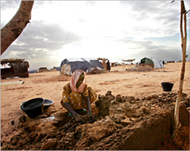Report: African famine may worsen
Tens of millions of Africans will continue to go hungry over the next 20 years unless major changes in trade and aid policies are enacted, a report forecasts.

More than 38.3 million children will suffer from malnutrition in 2025 if trends continue, and current policies will do little to improve long-term prospects, the International Food Policy Research Institute predicted in a report.
With millions already suffering from severe food shortages in the semi-arid lands along the Sahara, known as Africa’s Sahel region, the report said the entire continent needed at least $303.2 billion in new investments to reduce hunger.
Little change
“Many of the challenges facing Africa’s agricultural sector stem from a few root causes, including poor political and economic governance in many African countries, inadequate funding for the agricultural sector, poor water resources management, and neglect of research and development,” the report said.
The Washington-based institute’s researchers used computer modelling to analyse the effect of different trade, aid and agricultural policies to prepare a forecast for the next 20 years, depending on steps taken at the national and international level.
 |
|
The institute said current policies |
If there are no significant changes in the current policies, there will only be a small reduction in the percentage of malnourished children in sub-Saharan Africa from 32.8% to 28.2%. But when population growth is considered, the total number of hungry children will actually rise from 32.7 million to 38.3 million.
“A contributing factor to ongoing food insecurity under this scenario is the expected modest growth in agricultural production by historical standards to 2025,” the report said.
Pessimistic scenario
Adopting a pessimistic scenario, which factors in the effects of HIV/AIDS and the declining foreign investment in African countries, the institute predicted that the number of malnourished children in sub-Saharan Africa would rise to 55.1 million.
Researchers said the only way to meet the UN Millennium Development Goals of cutting the number of hungry in half by 2015 would be through reforming trade policies, significant financial investments, increased agricultural research and extension services, as well as better crop, land and water management.
Ensuring the empowerment of women should also be a priority, the report said.
“Overall, the scenarios modelled in this research show that policy choices and investment made now could substantially improve, or further worsen, the prospects for food security in Africa over the next two decades,” the report concluded.